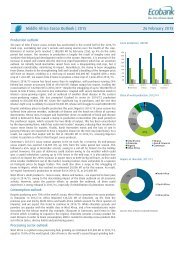www.ebook777.com
Make_Getting_Started_with_Processing_Second_Edition
Make_Getting_Started_with_Processing_Second_Edition
You also want an ePaper? Increase the reach of your titles
YUMPU automatically turns print PDFs into web optimized ePapers that Google loves.
Hello, Arduino<br />
Arduino is an electronics prototyping platform with a series of<br />
microcontroller boards and the software to program them. Processing<br />
and Arduino share a long history together; they are sister<br />
projects with many similar ideas and goals, though they<br />
address separate domains. Because they share the same editor<br />
and programming environment and a similar syntax, it’s easy to<br />
move between them and to transfer knowledge about one into<br />
the other.<br />
In this section, we focus on reading data into Processing from<br />
an Arduino board and then visualize that data on screen. This<br />
makes it possible to use new inputs into Processing programs<br />
and to allow Arduino programmers to see their sensor input as<br />
graphics. These new inputs can be anything that attaches to an<br />
Arduino board. These devices range from a distance sensor to a<br />
compass or a mesh network of temperature sensors.<br />
This section assumes that you have an Arduino board and that<br />
you already have a basic working knowledge of how to use it. If<br />
not, you can learn more online at http://<strong>www</strong>.arduino.cc and in<br />
the excellent book Getting Started with Arduino by Massimo<br />
Banzi (Maker Media). Once you’ve covered the basics, you can<br />
learn more about sending data between Processing and Arduino<br />
in another outstanding book, Making Things Talk by Tom Igoe<br />
(Maker Media).<br />
Data can be transferred between a Processing sketch and an<br />
Arduino board with some help from the Processing Serial<br />
Library. Serial is a data format that sends one byte at a time. In<br />
the world of Arduino, a byte is a data type that can store values<br />
between 0 and 255; it works like an int, but with a much smaller<br />
range. Larger numbers are sent by breaking them into a list of<br />
bytes and then reassembling them later.<br />
In the following examples, we focus on the Processing side of<br />
the relationship and keep the Arduino code simple. We visualize<br />
the data coming in from the Arduino board one byte at a time.<br />
With the techniques covered in this book and the hundreds of<br />
Arduino examples online, we hope this will be enough to get you<br />
started.<br />
Extend 193



